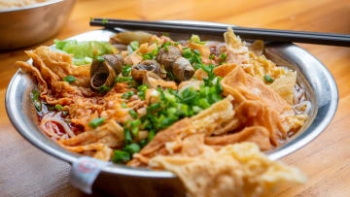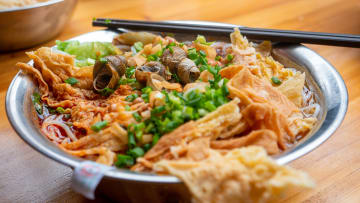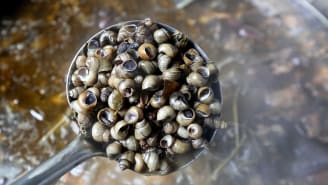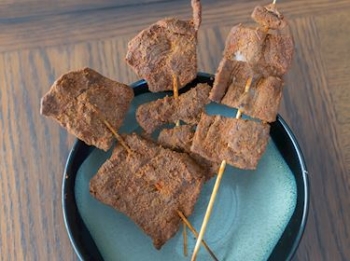profile/7421IMG-20200905-WA0125.jpg
Maryann5

FOOD AND DRINKS
~14.0 mins read
How the 'durian of soup' became the hippest dish in China
Serenitie Wang, CNN • Updated 9th November 2020

(CNN) — Unusual foods often gain cult followings.
But it's rare for an odorous dish to become a national favorite, which is exactly what's happened with luosifen, now one of the hottest food trends in China.
Just like the notorious durian fruit, this snail-based rice noodle soup dish has created a buzz on Chinese social media thanks to its infamous smell. While some claim the scent is mildly sour, others say it should be classed as a bioweapon.
Luosifen originated in Liuzhou, a city in China's north-central Guangxi autonomous province. It features rice vermicelli soaked in a spicy broth, topped with locally grown ingredients including bamboo shoots, string beans, turnips, peanuts and tofu skin.
Despite having the word "snail" in its Chinese name, actual snails don't commonly appear in the dish, but are used to flavor the broth.

Chinese workers produce soup for packaged luosifen at a factory in Liuzhou city.
Tan kaixing/Imaginechina/AP
"It only takes three bowls to get you hooked," Ni Diaoyang, head of the Liuzhou Luosifen Association and director of the Luosifen Museum in the city, tells CNN Travel proudly.
For a Liuzhou local like Ni, beyond the initial stench, a bowl of luosifen is a delicious concoction with rich and complicated flavors -- sour, spicy, savory and succulent.
In the past, it would have been hard for non-locals to share Ni's enthusiasm for this strange regional dish -- or even to try it. But luosifen's magic has unexpectedly spilled beyond its birthplace and overtaken the entire country, thanks to a DIY ready-to-eat form.
Pre-packaged luosifen -- which many describe as the "luxury version of instant noodles" -- usually comes with eight or more ingredients in vacuum-sealed packets.
Sales soared in 2019, leading it to become one of the best-selling regional snacks on Chinese e-commerce sites like Taobao. State media reported 2.5 million luosifen packets were produced daily in June 2020.
"The pre-packaged luosifen is truly a special product," says Min Shi, product manager of Penguin Guide, a leading Chinese food review site.
"I have to say it has an impressive consistency and quality control in flavors -- even better than some local store made ones," she adds.
Global brands like KFC are also latching onto this huge food trend. This month, the fast food giant rolled out new take-away products -- including packaged luosifen -- to appeal to young eaters in China.
While the Covid-19 pandemic almost obliterated the restaurant industry worldwide, the crisis turned out to be a blessing for luosifen makers.
Years before the pandemic began, noodle makers in Liuzhou were brewing an idea to take a different path from those exporting local specialty foods to other parts of China by opening chain restaurants or shops, such as Lanzhou hand-pulled noodles and Sha Xian Xiao Chi -- or Sha county snacks.
The ubiquity of chains offering these foods in branches all over the country is the result of deliberate efforts of local governments to turn their famous dishes into semi organized franchises.
A humble city in southwestern China, Liuzhou is a key base for the automotive industry, accounting for about 9% of the country's total auto production, according to city government data. With a population of 4 million, the city is home to more than 260 car parts manufacturers.
By 2010, luosifen had already earned a following after being featured in hit culinary documentary "A Bite of China."
Specialized luosifen chains started to pop up in Beijing and Shanghai. But despite some initial fanfare and a government push, in-store sales fell flat.

An aerial view of Liuzhou's luosifen factories.
Huang Dou/Imaginechina/AP
Then in 2014, Liuzhou entrepreneurs had an idea: Mass produce the noodles and package them.
At first, it wasn't easy. The noodles, first made in shabby workshops, would only last for 10 days. Authorities cracked down on some workshops over hygiene concerns.
The setbacks didn't slow the momentum in a city renowned for its assembly and standardization capabilities.
As more luosifen workshops popped up, the Liuzhou government started to regulate production and award licenses to factories that met certain requirements, according to state media.
Government efforts have led to more research and upgraded technologies in food prep, processing, sterilization and packaging. Nowadays, most luosifen packages on the market have a shelf life of up to six months, which allows people, near or far, to enjoy the same flavors with minimal preparation.
"In inventing the luosifen packages, Liuzhou people borrowed the 'industrial thinking' of the city," Ni says.
While the snail may stand out as the most unusual ingredient in luosifen, local bamboo shoots are what give soul to the noodle soup.
Luosifen's arguably off-putting scent comes from fermented "suan sun" -- sour bamboo shoots. Despite being produced in a factory, every bamboo shoot packet sold with luosifen is handmade according to Liuzhou traditions, say manufacturers.
Bamboo shoots are highly prized in China, their crunchy and tender texture making them a supporting ingredient in many gourmet recipes.
But as bamboo grows fast, the taste window for its shoots is extremely short, which poses challenges for preparation and preservation.

A Chinese worker packs pickled bamboo shoots, which give luosifen its distinctive smell.
Tan kaixing/Imaginechina/AP
To retain the utmost freshness, farmers in Liuzhou's suburbs get up before dawn for the hunt. Aiming for the tip of the plant, as it's just surfacing from the ground, they carefully cut off the shoots above the rhizome. Before 9 a.m., the plants are harvested and handed to the processing factories.
The bamboo shoots will then be unsheathed, peeled and slivered. The slices will sit in the pickling liquid for at least two months.
The secret sauce of pickling, according to Ni, is the mix of local Liuzhou spring water and aged pickle juice. Every new batch contains 30 to 40% of the old juice.
The ensuing fermentation isn't just a waiting game. It also needs to be mindfully monitored. Seasoned "pickle sommeliers" are paid to sniff the "sour bamboo shoots" to track the fermentation stages.
Though it admittedly draws inspiration from convenience food, packaged luosifen shouldn't be classed as such, says Ni. Instead, he prefers to refer to it as a "local specialty food," because neither the quality nor the freshness has been compromised.
"Luosifen producers use spices -- star anise, numbing peppers, fennel and cinnamon -- as natural preservatives in addition to flavorings," Ni says. "Depending on the recipe, there are at least 18 spices in the broth."
Rather than adding flavoring powders, the luosifen broth -- often condensed in packets -- is created through protracted cooking processes, with bulks of snails, chicken bones and pig marrow bones sitting in rolling boils for more than 10 hours.
The making of the Luosifen noodles takes at least seven procedures over two full days
Hangzhou Weinian
The elaborate process also applies to the rice noodles -- the main character of the dish. From grinding grains to steaming to drying to packaging, it takes at least seven procedures carried out over two full days -- already a largely shortened time thanks to automation -- to achieve the foolproof "al dente" state.
However cooked, the noodles will turn silky and slippery, while setting off all the bold flavors in the bowl.
"People staying home now have higher expectations for convenience food. And it's much more than filling the belly; they want to engage in a ritual to make something delicious," Shi says.
The luosifen frenzy in China has been propelled by pop culture -- including culinary shows, memes and mukbang videos.
One of the most watched videos featuring luosifen is by Li Ziqi, a Chinese blogger who showcases traditional cooking styles, with everything made from scratch and sourced from the pastoral, dreamy countryside.
Her luosifen video, which features her sawing off bamboo shoots and hand-catching river snails, has been viewed more than 53 million times on YouTube.
Li, an ambassador for traditional food culture, has even started her own luosifen brand. Her company, Hangzhou Weinian Brand Management. is now setting up a dedicated factory and securing a bamboo shoot farm for an exclusive supply, say representatives.
But even someone with as much clout as Li Ziqi is only cautiously eyeing the overseas market. Xiaodao Li, Li Ziqi's brand director, says they don't have any exporting plans at this stage.
"Luosifen is a dish dependent on the authenticity of the ingredients. We want to ensure the supply for the domestic market first," he says.
"However, we've seen many foreign friends, who snub the idea at first, end up gulping up the entire bowl. So, we wouldn't rule out the possibility to test the water in some regions."
Indeed, having already taken China by storm, the dish is now gaining fans in the rest of the world.
According to the in-house research arm of Chinese e-commerce site Alibaba, packaged luosifen has already been sold to more than 100 countries or regions, while the local commerce authority reports that exports of the food skyrocketed in 2020.
From January to August, international sales hit $3.1 million -- 22 times their total export value in 2019.
The biggest challenge though, according a leading luosifen exporter, is to meet the various customs inspection requirements.
Yao Hanlin, chairman of luosifen brand Luobawang, says his company has to tailor recipes and techniques. For instance, the brand has developed a fish-based broth specifically for the US market, as the country bars certain animal-sourced ingredients.
For the Japan market, they have to source bamboo shoots that are free of a specific mineral element.
Yao says after clearing these customs hurdles, they are working to diversify the product to cater to more palates by adding tomato, numbing peppers and hot and sour flavors.
Read more
profile/7421IMG-20200905-WA0125.jpg
Maryann5

TASTE AT LAST
~72.8 mins read
WHAT TO EAT IN NIGERIA?Top 10MOST POPULAR NIGERIAN FOODS
VIEW MORE
Afang is a traditional soup hailing from the southeastern parts of Nigeria. It's made with a combination of afang leaves, water leaves, dried fish, beef, onions, red palm oil, ground crayfish, and seasoning cubes. The afang leaves are ground or pounded and the onions are chopped before the beef is boiled with the onions and seasoning cubes in a small quantity of water.
When done, the dried fish is added with the palm oil, ground pepper, afang leaves, and water leaves. Once the leaves become tender and the liquids evaporate a bit, the soup is simmered for a short while before it's ready to be served. Afang soup is typically served at festive events such as weddings and celebrations.
It's especially popular among the Efiks, people of Akwa Ibom and Cross River states.
ARTICLE CONTINUES AFTER THIS AD
Ogbono is a traditional Nigerian soup made with a combination of ogbono seeds, red palm oil, onions, stock, seasoning cubes, leafy vegetables such as spinach, pumpkin leaves, or bitterleaf, and assorted meat and fish such as beef, tripe, shrimp, and crayfish.
The ingredients are simmered in an uncovered pot until fully tender, and the soup is then traditionally served hot with fufu, because the soup's slimy consistency helps the lumps of fufu slide down. Ogbono has many versions, so it can also be made without vegetables.
SERVE WITH
FufuNkwobi, a savory Nigerian side dish originates from the Igbo tribe, located in the southeastern part of Nigeria. The dish is usually prepared with a cow’s leg that’s cooked in a thick, spicy sauce, but it can also be made with a combination of cow’s tail, goat meat, and chicken.
In the past, nkwobi used to be prepared with bush meat such as squirrels, rabbits, and even antelopes.
ARTICLE CONTINUES AFTER THIS AD
Eba or garri is a Nigerian staple food consisting of cassava flour combined with hot water. The combination is traditionally mixed with a large wooden spoon until it firms up, and is then rolled into a ball. Eba is served with almost all Nigerian soups.
It can be dipped into the soups, but it's also often served with stews and various meat dishes.
Moin moin is a Nigerian dish consisting of ground beans or black-eyed peas, onions, oil, and freshly ground peppers such as chili, bell pepper, and Scotch bonnet. The dish is usually served as an accompaniment to jollof rice, fried plantains, and akamu.
It can also be consumed on its own as a snack. Moin moin is so popular that it is regularly served at celebrations and similar special occasions.
Believed to have originated among the Hausa people, this popular Nigerian dish employs thin slices of beef or chicken that are generously seasoned, then roasted over open charcoal grills. The essential element in each suya is a dry spice blend known as suya or yaji, which is made with a combination of ground peanuts and red peppers.
The spice blend is versatile, and depending on the region, it may incorporate various additional ingredients. In Nigeria, the skewers are usually sold individually and are mainly enjoyed on the go as a quick, cheap, and nutritious snack. In restaurants, they are often paired with vegetables such as sliced onions or tomatoes.
Along with being a staple throughout Nigeria, suya is also found in other parts of Western Africa.
WHERE TO EAT THE BEST SUYA IN NIGERIA
Jollof rice is Nigeria's national dish. In order to prepare it, rice is cooked in a rich tomato sauce so that it soaks in all the flavors. The most common ingredients found in jollof rice include rice, tomatoes, tomato paste, onions, salt, and pepper.
On top of that, any kind of meat, vegetable, fish or spice can be added. It is important to have a delicious sauce, so in addition to tomatoes, there are also ingredients such as coconut milk, nutmeg, partminger (African basil leaf) and sometimes even Roiboos tea used in the sauce.
The other name for the dish is benachin, meaning one pot in the native language of the Wolof people who created it. Although it is a Nigerian dish with Senegalese origins, it can be found all over West Africa with some variations in the ingredients, and it's believed that jollof rice is the predecessor to the popular Cajun dish jambalaya.
SERVE WITH
GizdodoWHERE TO EAT THE BEST JOLLOF RICE IN NIGERIA
ARTICLE CONTINUES AFTER THIS AD

SHOW MAP
Nigerian Food
VIEW MORE
© 2020 AtlasMedia Ltd. (EU) - All Rights Reserved
Advertisement

Link socials
Matches
Loading...















